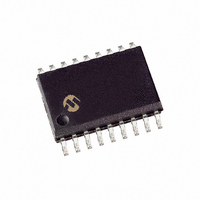PIC16C54B-04I/SO Microchip Technology, PIC16C54B-04I/SO Datasheet - Page 9

PIC16C54B-04I/SO
Manufacturer Part Number
PIC16C54B-04I/SO
Description
MICRO CTRL 512 4MHZ OTP 18SOIC
Manufacturer
Microchip Technology
Series
PIC® 16Cr
Specifications of PIC16C54B-04I/SO
Core Processor
PIC
Core Size
8-Bit
Speed
4MHz
Peripherals
POR, WDT
Number Of I /o
12
Program Memory Size
768B (512 x 12)
Program Memory Type
OTP
Ram Size
25 x 8
Voltage - Supply (vcc/vdd)
3 V ~ 5.5 V
Oscillator Type
External
Operating Temperature
-40°C ~ 85°C
Package / Case
18-SOIC (7.5mm Width)
Lead Free Status / RoHS Status
Request inventory verification / Request inventory verification
Eeprom Size
-
Data Converters
-
Connectivity
-
- Current page: 9 of 218
- Download datasheet (2Mb)
3.0
The high performance of the PIC16C5X family can be
attributed to a number of architectural features
commonly found in RISC microprocessors. To begin
with, the PIC16C5X uses a Harvard architecture in
which program and data are accessed on separate
buses. This improves bandwidth over traditional von
Neumann architecture where program and data are
fetched on the same bus. Separating program and
data memory further allows instructions to be sized
differently than the 8-bit wide data word. Instruction
opcodes are 12-bits wide making it possible to have all
single word instructions. A 12-bit wide program
memory access bus fetches a 12-bit instruction in a
single cycle. A two-stage pipeline overlaps fetch and
execution of instructions. Consequently, all instructions
(33) execute in a single cycle (200ns @ 20MHz)
except for program branches.
The PIC16C52 addresses 384 x 12 of program
memory, the PIC16C54s/CR54s and PIC16C55s
address
PIC16C56s/CR56s address 1K X 12 of program
memory,
PIC16C58s/CR58s address 2K x 12 of program
memory. All program memory is internal.
The PIC16C5X can directly or indirectly address its
register files and data memory. All special function
registers including the program counter are mapped in
the data memory. The PIC16C5X has a highly
orthogonal (symmetrical) instruction set that makes it
possible to carry out any operation on any register
using any addressing mode. This symmetrical nature
and
programming with the PIC16C5X simple yet efficient.
In addition, the learning curve is reduced significantly.
1998 Microchip Technology Inc.
lack
ARCHITECTURAL OVERVIEW
512 x 12
and
of ‘special
the
of
optimal
PIC16C57s/CR57s
program
situations’ make
memory,
and
Preliminary
the
The PIC16C5X device contains an 8-bit ALU and
working register. The ALU is a general purpose
arithmetic unit. It performs arithmetic and Boolean
functions between data in the working register and any
register file.
The ALU is 8-bits wide and capable of addition,
subtraction, shift and logical operations. Unless
otherwise mentioned, arithmetic operations are two's
complement in nature. In two-operand instructions,
typically one operand is the W (working) register. The
other operand is either a file register or an immediate
constant. In single operand instructions, the operand
is either the W register or a file register.
The W register is an 8-bit working register used for
ALU operations. It is not an addressable register.
Depending on the instruction executed, the ALU may
affect the values of the Carry (C), Digit Carry (DC),
and Zero (Z) bits in the STATUS register. The C and
DC bits operate as a borrow and digit borrow out bit,
respectively, in subtraction. See the SUBWF and ADDWF
instructions for examples.
A simplified block diagram is shown in Figure 3-1, with
the corresponding device pins described in Table 3-1.
PIC16C5X
DS30453B-page 9
Related parts for PIC16C54B-04I/SO
Image
Part Number
Description
Manufacturer
Datasheet
Request
R

Part Number:
Description:
MICRO CTRL 512 4MHZ OTP 18DIP
Manufacturer:
Microchip Technology
Datasheet:

Part Number:
Description:
MICRO CTRL 512 4MHZ OTP 18SOIC
Manufacturer:
Microchip Technology
Datasheet:

Part Number:
Description:
MICRO CTRL 512 20MHZ OTP 18SOIC
Manufacturer:
Microchip Technology
Datasheet:

Part Number:
Description:
MICRO CTRL 512 X 12 EPROM 18CDIP
Manufacturer:
Microchip Technology
Datasheet:

Part Number:
Description:
MICRO CTRL 512 4MHZ OTP 18DIP
Manufacturer:
Microchip Technology
Datasheet:

Part Number:
Description:
MICRO CTRL 512 4MHZ OTP 20SSOP
Manufacturer:
Microchip Technology
Datasheet:

Part Number:
Description:
MICRO CTRL 512 4MHZ OTP 20SSOP
Manufacturer:
Microchip Technology
Datasheet:

Part Number:
Description:
MICRO CTRL 512 20MHZ OTP 18DIP
Manufacturer:
Microchip Technology
Datasheet:

Part Number:
Description:
MICRO CTRL 512 20MHZ OTP 18SOIC
Manufacturer:
Microchip Technology
Datasheet:

Part Number:
Description:
MICRO CTRL 512 20MHZ OTP 20SSOP
Manufacturer:
Microchip Technology
Datasheet:

Part Number:
Description:
MICRO CTRL 512 20MHZ OTP 18DIP
Manufacturer:
Microchip Technology
Datasheet:

Part Number:
Description:
MICRO CTRL 512 20MHZ OTP 20SSOP
Manufacturer:
Microchip Technology
Datasheet:

Part Number:
Description:
Manufacturer:
Microchip Technology Inc.
Datasheet:










